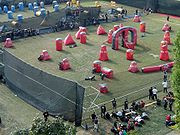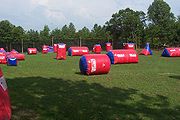
Speedball
Encyclopedia

Paintball
Paintball is a sport in which players compete, in teams or individually, to eliminate opponents by tagging them with capsules containing water soluble dye and gelatin shell outside propelled from a device called a paintball marker . Paintballs have a non-toxic, biodegradable, water soluble...
, the other being woodsball
Woodsball
Woodsball is a format of paintball gaming, in which players compete in a natural outdoors area using paintball markers to tag opponents....
. It is a general term for a game in which the playing field is composed of bunkers, of the same location and number on each side of the field, that provide an equal playing field for each team competing. It was created in this way to give a better format for competitive paintball, both in playing and viewing the games.
General
Paintball is the most widely played extreme sport in the United StatesUnited States
The United States of America is a federal constitutional republic comprising fifty states and a federal district...
, due to the popularity of the speedball variant in professional leagues. Speedball evolved paintball into a more formalized game, with each league having a differing format. Paintball was originally a recreational activity, but became a sport with the advent of organized speedball tournaments; professional teams making use of coaching, corporate endorsements, media coverage, and fan followings.
History

Game play
Speedball is a team game, and can be played recreationally or professionally; with tournaments usually specifying teams of three, five, seven, and even ten players. The game is characterized by a small symmetrical playing field, filled with artificial terrain (such as inflatable bunkers), and a game time of several minutes. This is in contrast to woodsballWoodsball
Woodsball is a format of paintball gaming, in which players compete in a natural outdoors area using paintball markers to tag opponents....
, where fields are very large, using primarily natural terrain features, and some games can take hours. Stealth and concealment is of little use on a speedball field; there is very little to blend in with. Professional teams will instead rely on teamwork, aggressive movement and constant communication to win a game. Players wear brightly colored jerseys and pants to indicate their team, similar to other sports, with a professional team sometimes having sponsor logos and the team name.
Tournament speedball leagues specify the points system to be used for games. For example, in the National Professional Paintball League
National Professional Paintball League
The National Professional Paintball League is one of two American paintball national tournament series that travel throughout the United States each year, and was also the largest professional seven-man paintball league in the world.-History:...
s opposing flag format, points are awarded for staying in the game the whole round, shooting someone out, grabbing the flag, and hanging the flag. PSP uses the XBall format, where a match between two teams involves multiple games of center flag; there is a flag in the center of the field, and a team is awarded a point every time the flag is captured and hung on the opposing team's start box. Teams can play to a certain number of points, or to a set time limit.
Because of the small size and openness of the field, suppressing fire is a primary element of speedball tactics; the team who is better able to keep their opponents pinned behind cover while they themselves are free to move will have an enormous advantage. Therefore, the number of shots fired by each player in the game is significantly higher than in other paintball game formats.
Leagues
There are a variety of paintball leagues that employ speedball as their format for tournaments. Two of the main national leagues are the NPPL (National Professional Paintball league, formerly the United States Paintball League or USPL) and PSP (Paintball Sports Promotions), which sponsors tournaments under this name and also owns the pro-level National Xball League or NXLNXL
The NXL was a paintball league based in the United States. The league consisted of franchised and non-franchised teams, and was owned by the franchise teams. NXL competition was held in conjunction with PSP events...
. Each has its own professional and amateur divisions and has slightly different rules. The Millennium Series is Europe's national league and features rules and styles of game play similar to that of the PSP, NPPL and LAPPL.
Sponsorships, television endorsements, extensive media coverage, and nationwide events have all pushed the leagues into mainstream popularity. In 2007, at World Cup, the most popular PSP event located at Disney’s Wide World of Sports Complex, boasted over 35,000 spectators and featured 373 teams. There are also numerous regional and local events all over the world, including most paintball fields which many times host their own events.
Markers
Speedball paintball markerPaintball marker
A paintball marker, also known as a paintball gun, is the main piece of equipment in the sport of paintball. Markers use an expanding gas, such as carbon dioxide or compressed air, to propel paintballs through the barrel. Some paintball players refer to the piece of equipment as a "marker" rather...
s are designed to be small so they do not present a large target; in virtually all tournament rulesets, a player is eliminated if they, or anything they are wearing or holding including their marker, is hit. Tournaments also specify allowable firing modes and rates of fire. For instance, PSP league rules place a 12.5 bps (balls per second) limit or "cap" on rate of fire, but allow a marker to "ramp" (shoot additional shots per trigger pull) when the trigger is pulled rapidly. The NPPL uses a semi-automatic uncapped rule where players can shoot at any speed, but may not use a ramping mode. The circuitry of modern electropneumatic markers generally incorporates specific firing modes that follow each league's basic rules. Beyond regulations to rate of fire, some paintball markers use anti-chop eyes to prevent the marker firing without a paintball securely seated in the breech. This ensures that a paintball which has only fed halfway is not "chopped" in half as the bolt closes the breech, which will affect accuracy of subsequent shots. There are various designs of hopper on the market, in two main families: gravity-fed designs, including unpowered and agitating models, in which balls simply fall down the feed tube into the marker, and force-fed designs that use a belt or carousel to actively push paint through the feed neck into the marker faster than gravity would be able to do so (up to 50bps or more).
Modern speedball markers tend to be electro-pneumatic in design, and run off compressed air or nitrogen. Slightly older models of speedball guns used to run mechanically, but higher rates of fire could not be reached due to longer trigger pulls and heavier pull weights. Electronic markers replace the often heavy and long pull of a mechanical trigger, needed to manipulate the mechanical linkage to the firing mechanism, with a simple electronic button or other sensor that detects a trigger pull. As a result, electropneumatic markers' trigger pulls are often measured in millimeters of travel and just a few grams of pull weight, allowing for very fast rates of fire using various techniques of "walking" the trigger (alternating pulling the trigger with index and middle fingers).
The technology of Speedball markers has been advancing over time. Every year companies make guns more consistent, accurate, reliable and convenient. Although this technology can become costly, some players are willing to invest in spending large amounts of money into their markers. The advancement of technology in markers also means that less-expensive technologies, usually based around the circuitry of a marker, can be integrated into lower-cost markers, making entry-level speedball markers very competitive in many ways to higher-cost models. Also, as markers become more advanced, hoppers must also be able to keep up with the achievable high rates of fire.

